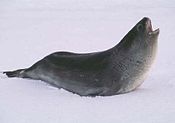Lobodontini
| Lobodontine seals[1] Temporal range: Late Miocene to recent
| |
|---|---|

| |
| Crabeater seal, Lobodon carcinophaga | |
| Scientific classification | |
| Domain: | Eukaryota |
| Kingdom: | Animalia |
| Phylum: | Chordata |
| Class: | Mammalia |
| Order: | Carnivora |
| Clade: | Pinnipedia |
| Family: | Phocidae |
| Subfamily: | Monachinae |
| Tribe: | Lobodontini J. E. Gray, 1869 |
| Genera | |
The
pack ice
. Thus, though they are collectively the most abundant group of seals in the world, the combination of remote range and inaccessible habitat make them among the least well studied of the world's seals.
Adaptations

The Lobondontini are thought to have diverged from the
penguins, while still retaining the ability to filter-feed on krill.[4]
Abundance
The lobodontin seals in aggregate are among the most successful of all marine mammal groups, collectively accounting for at least 50% of all seals on Earth and about 80% of the global
baleen whales in the Antarctic due to commercial whaling in the 19th and 20th centuries, and the subsequent increase in krill densities.[7] Genetic evidence suggests that Weddell and crabeater seal populations may have increased in size during the Pleistocene.[8]
None of the four species is currently thought to be declining in numbers.
Genera
| Image | Genus | Species |
|---|---|---|

|
Lobodon Gray, 1844
|
|

|
Hydrurga Gistel, 1848
|
|

|
Ommatophoca Gray, 1844
|
|

|
Leptonychotes Gill, 1872
|
|
References
- OCLC 62265494.
- PMID 33391813.
- PMID 33171079.
- ISBN 978-0-12-373553-9.
- ^ Laws, R.M. Seals. In: Laws, R.M. (ed) Antarctic Ecology, Vol. 2, Academic Press, London, pp. 621-675
- ^ Erickson, A. W., Siniff, D. B., Cline, D. R. and Hofman, R. J. (1971). Distributional ecology of Antarctic seals. In: G. Deacon (ed.), Symposium on Antarctic Ice and Water Masses, pp. 55-76. Sci. Comm. Antarct Res., Cambridge, UK.
- ^ Mori, M.; Butterworth, D. (2006). "A first step towards modelling the krill-predator dynamics of the Antarctic ecosystem". CCAMLR Science. 13: 217–277.
- S2CID 5323435.




